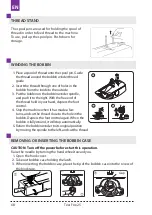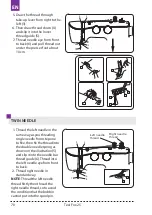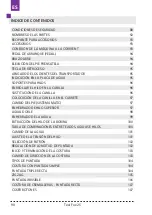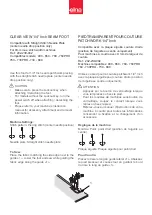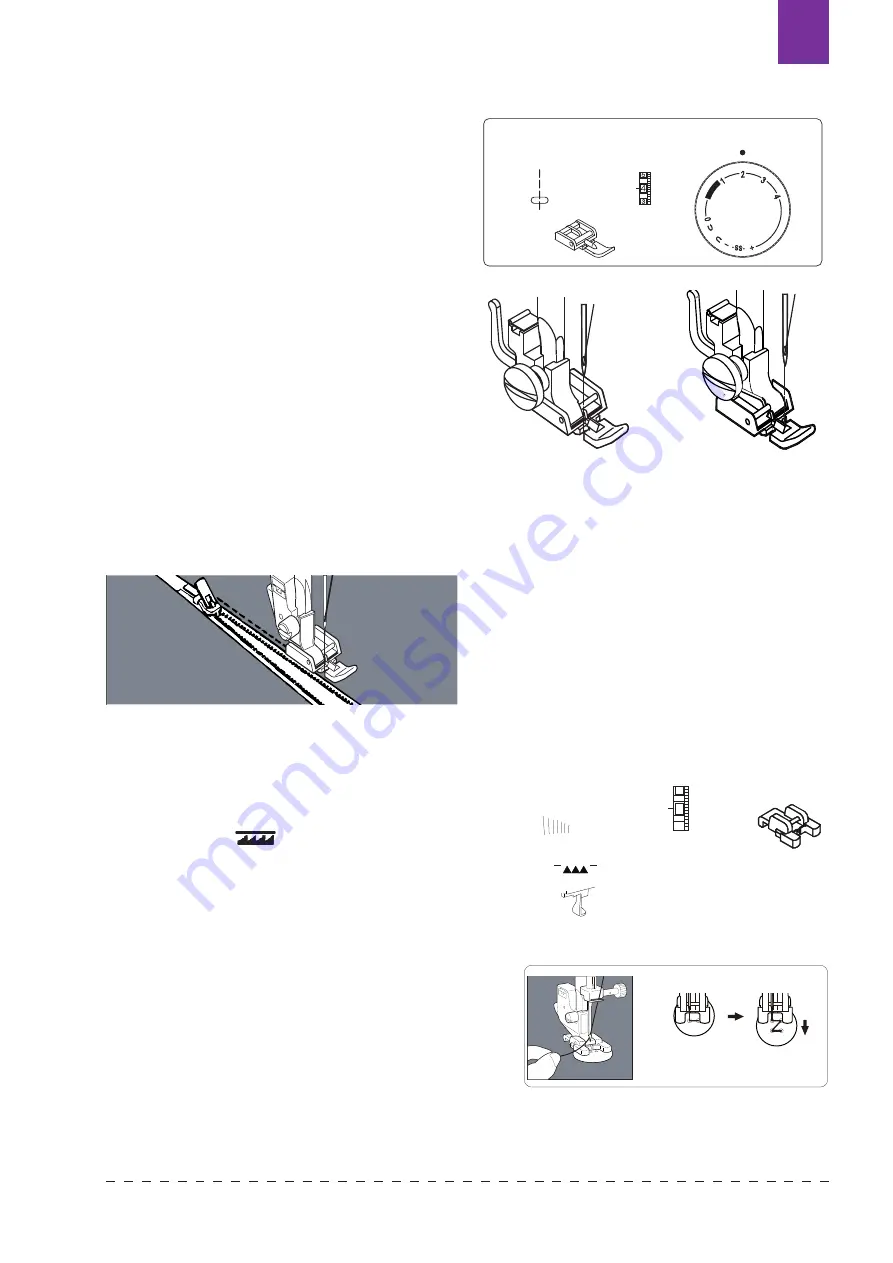
EN
INSERTING ZIPPERS AND PIPING
BUTTON SEWING
PRESSER FOOT - ZIPPER FOOT
1.
Use zipper foot to sew to the right or left
of the zipper or close to the cord
2.
Align the right side of the left side of
the zipper foot pin with the presser foot
holder, lower the presser foot lever to
attach the foot
3.
To insert zippers, consult the zipper
package for instructions on how to
prepare zipper placket and place zipper.
4.
To sew close to the zipper on the right
side, snap the zipper foot onto the presser
foot holder on the left side so the needle
passes through the opening on the left
side of the foot.
5.
Snap the foot onto the presser foot holder
on the other side of the foot to sew close
to the left side to the zipper.
PRESSER FOOT - BUTTON FITTING FOOT
1.
Attach button fitting foot
2.
Push the lever in the direction of the arrow to drop
the feed dog
3.
Position your fabric and button under the presser
foot. Lower presser foot. Turn the handwheel
to make sure needle clears both left and right
openings of button
4.
Lower the foot and adjust stitch width to match
with needles to right hole of the button.
5.
Sew 6-7 stitches (10 on heavy material). Turn
needle to its highest position.
6.
To secure thread, pull both threads to the
backside of the fabric and tie together.
Depends if you sew right or left side of the
zipper, needle should always be closed to
the zipper
18
UTILITY STITCHES
Helpful hint:
During zipper inserting, ensure that the
needle do not touch the zipper. Otherwise
it will cause needle break or even injury.
Buttonhole stitch
Zipper
application
Tips:
Slightly reduce the upper tension to
produce better results.
Use backing material for fine or
stretchy materials.
We recommend placing a pin across
the end of the buttonhole as a
precaution against cutting the stitches
with the seam ripper.
It is advisable to use gimp cord for
stretch or knit fabrics. The zigzag
should sew over the gimp.
The lines on the buttonhole foot can be
used guides when sewing multiple
buttonholes.
1. Lift the presser foot, pull the gimp cord and come round the protruding point on back of the
buttonhole foot.
2. Pull the gimp cord under the foot to the front.
3. Fix the gimp cord to the protruding point on front of foot.
4. Turn the needle down to the starting position on fabric, put down the presser foot.
5. Sew the buttonhole according to page 17.
6. Pull the gimp cord straightly.
7. Cut the gimp cord.
Attach the zipper foot.
When sewing the right side of the zipper, attach the
zipper foot as the illustration in right.
When sewing the left side of the zipper, attach the
zipper foot as the illustration in right.
Sew the right side
of the zipper.
Sew the left side
of the zipper.
A
3~6
2
Machine
Setting
18
UTILITY STITCHES
Helpful hint:
During zipper inserting, ensure that the
needle do not touch the zipper. Otherwise
it will cause needle break or even injury.
Buttonhole stitch
Zipper
application
Tips:
Slightly reduce the upper tension to
produce better results.
Use backing material for fine or
stretchy materials.
We recommend placing a pin across
the end of the buttonhole as a
precaution against cutting the stitches
with the seam ripper.
It is advisable to use gimp cord for
stretch or knit fabrics. The zigzag
should sew over the gimp.
The lines on the buttonhole foot can be
used guides when sewing multiple
buttonholes.
1. Lift the presser foot, pull the gimp cord and come round the protruding point on back of the
buttonhole foot.
2. Pull the gimp cord under the foot to the front.
3. Fix the gimp cord to the protruding point on front of foot.
4. Turn the needle down to the starting position on fabric, put down the presser foot.
5. Sew the buttonhole according to page 17.
6. Pull the gimp cord straightly.
7. Cut the gimp cord.
Attach the zipper foot.
When sewing the right side of the zipper, attach the
zipper foot as the illustration in right.
When sewing the left side of the zipper, attach the
zipper foot as the illustration in right.
Sew the right side
of the zipper.
Sew the left side
of the zipper.
A
3~6
2
Machine
Setting
18
UTILITY STITCHES
Helpful hint:
During zipper inserting, ensure that the
needle do not touch the zipper. Otherwise
it will cause needle break or even injury.
Buttonhole stitch
Zipper
application
Tips:
Slightly reduce the upper tension to
produce better results.
Use backing material for fine or
stretchy materials.
We recommend placing a pin across
the end of the buttonhole as a
precaution against cutting the stitches
with the seam ripper.
It is advisable to use gimp cord for
stretch or knit fabrics. The zigzag
should sew over the gimp.
The lines on the buttonhole foot can be
used guides when sewing multiple
buttonholes.
1. Lift the presser foot, pull the gimp cord and come round the protruding point on back of the
buttonhole foot.
2. Pull the gimp cord under the foot to the front.
3. Fix the gimp cord to the protruding point on front of foot.
4. Turn the needle down to the starting position on fabric, put down the presser foot.
5. Sew the buttonhole according to page 17.
6. Pull the gimp cord straightly.
7. Cut the gimp cord.
Attach the zipper foot.
When sewing the right side of the zipper, attach the
zipper foot as the illustration in right.
When sewing the left side of the zipper, attach the
zipper foot as the illustration in right.
Sew the right side
of the zipper.
Sew the left side
of the zipper.
A
3~6
2
Machine
Setting
16
UTILITY STITCHES
Sewing
buttons
To secure thread, cut the upper thread with 25cm of excess, wind it
around the thread between the button and the fabric, and then tie it
tightly.
Position your fabric and button under the presser foot. Lower presser foot. Turn the
handwheel to make sure needle clears both left and right openings of button. Adjust
width if required. Sew 10 stitches across.
When attaching four-hole buttons, first sew the two holes closest to you. Then, slide the
button so that the needle goes into the two holes toward the rear of the sewing machine,
and then sew them in the same way.
1
2
3
C~B
Machine Setting
1~3
NOTE: 1. Drop the feed dog (Refer to page 4) .
After you finish sewing, set the drop feed
lever to the original position.
2. You do not have to adjust the stitch length dial.
Drop
the
feed
dog
16
UTILITY STITCHES
Sewing
buttons
To secure thread, cut the upper thread with 25cm of excess, wind it
around the thread between the button and the fabric, and then tie it
tightly.
Position your fabric and button under the presser foot. Lower presser foot. Turn the
handwheel to make sure needle clears both left and right openings of button. Adjust
width if required. Sew 10 stitches across.
When attaching four-hole buttons, first sew the two holes closest to you. Then, slide the
button so that the needle goes into the two holes toward the rear of the sewing machine,
and then sew them in the same way.
1
2
3
C~B
Machine Setting
1~3
NOTE: 1. Drop the feed dog (Refer to page 4) .
After you finish sewing, set the drop feed
lever to the original position.
2. You do not have to adjust the stitch length dial.
Drop
the
feed
dog
Texi Fox 25
79
Summary of Contents for Fox 25
Page 1: ...MULTIFUNCTIONAL SEWING MACHINE 2 A L K J I H G F E D C B 3...
Page 2: ......
Page 5: ...Texi Fox 25 5 CS...
Page 172: ...RU 1 2 3 1 2 3 4 5 6 7 8 9 Texi Fox 25 172...
Page 173: ...RU 10 11 12 13 14 15 16 17 Texi Fox 25 173...
Page 175: ...RU 192 193 193 194 194 194 194 195 195 195 196 196 198 Texi Fox 25 175...
Page 193: ...RU 1 A 2 3 4 5 6 H 3 9 2 3 Machine Setting Texi Fox 25 193...
Page 195: ...RU 4 10 1 2 2 3 D 1 4 S S Machine Setting 10mm 3 8 Wrong side of fabric Texi Fox 25 195...
Page 196: ...RU 4 1 2 3 4 1 2 5 6 Texi Fox 25 196...
Page 197: ...RU 1 3 4 1 2 2 4 6 Texi Fox 25 197...
Page 198: ...RU Texi Fox 25 198...




